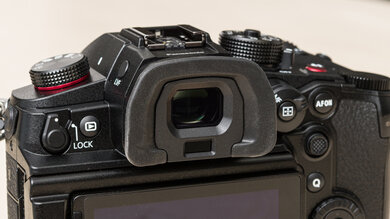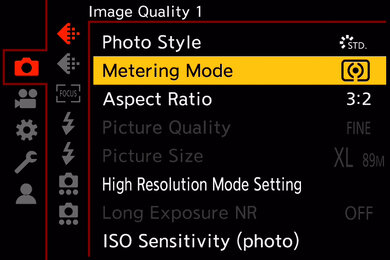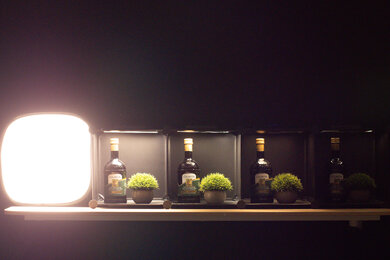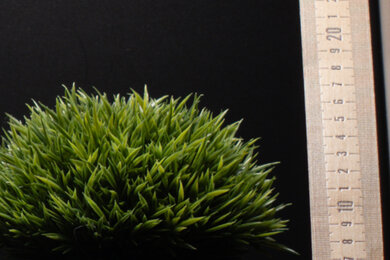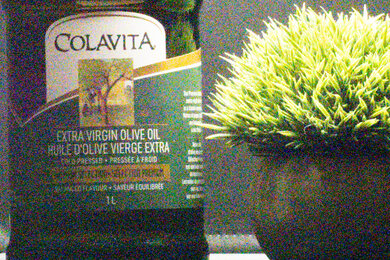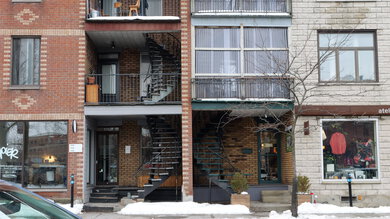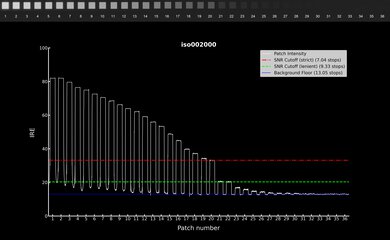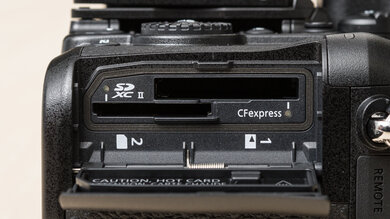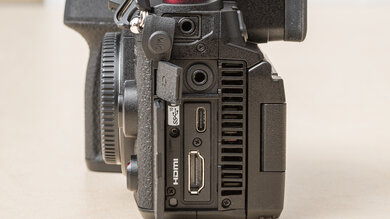The Panasonic LUMIX GH6 is a high-end Micro Four Thirds (MFT) camera. This video-centric hybrid model is the follow-up to the Panasonic LUMIX GH5 II and a highly advanced option for videography. It has some new design features over its predecessor, including a unique tilting/fully articulated screen, a CFexpress card slot with a secondary SD slot, and built-in heat vents for active cooling. Internally, it's just as impressive, with 4k 120fps recording, internal Apple ProRes recording in 5.7k, and open gate 5.8k recording. The camera's dual output gain sensor promises a boost in dynamic range, and the in-body image stabilization (IBIS) is one of the most effective on the market. That said, unlike the newer Panasonic LUMIX G9 II, the GH6 still uses contrast-detection autofocus, which doesn't have the speed of phase-detection systems. If you rely heavily on autofocus, that may be a dealbreaker, but otherwise, this camera has plenty to offer.
Our Verdict
Though it's a more video-centric camera, the Panasonic GH6 is good for travel photography if you don't mind a bulkier body. It isn't very portable for long days on the go, but you can still pair it with more compact MFT lenses to keep the overall size of your kit down a bit. Its high-resolution sensor captures high-quality, detailed images, and there are a wide range of lenses to choose from. Its IBIS system is also incredibly effective at minimizing hand shake when taking photos, letting you shoot at slow shutter speeds without a tripod. It's also an incredibly well-built and ergonomic camera with extensive weather-sealing and customizable physical controls. Unfortunately, its battery life is just okay, but how much mileage you get out of it will depend on your settings and shooting habits.
- Excellent IBIS system.
- Relatively high resolution sensor.
- Fantastic build quality with weather-sealing.
- Not very portable.
- Internal battery life is just okay.
The Panasonic LUMIX DC-GH6 is great for landscape photography. It captures great overall image quality, with excellent overall dynamic range to capture a wider range of detail in high-contrast scenes. Its IBIS system is incredibly effective for those who prefer to shoot without a tripod, and the camera's 'High Resolution' mode takes advantage of the IBIS to shoot several frames and combine them into a composite image of up to 100 MP to get remarkably detailed images. The camera is very sturdy, with full weather sealing and amazing ergonomics. However, it isn't very portable.
- Excellent IBIS system.
- Excellent dynamic range.
- Relatively high resolution sensor.
- Not very portable.
- Internal battery life is just okay.
The Panasonic GH6 is great for sports and wildlife photography. The MFT system includes a wide range of relatively compact telephoto lens options, though the camera body isn't especially portable. It offers quick mechanical burst shooting at up to 14 fps; however, that drops down to 8 fps when using AF-C. Meanwhile, its e-shutter allows bursts of up to 75 fps, which is incredible for capturing very brief moments of fast action. That said, the camera's slow sensor readout speed can cause rolling shutter artifacts in e-shutter mode, so it isn't the best option for tracking moving subjects. The camera's autofocus system also uses a slower contrast-based system that can struggle to keep faster subjects in focus.
- Excellent IBIS system.
- Quick burst shooting.
- Long reach with MFT lenses.
- Internal battery life is just okay.
- Contrast-detection autofocus isn't the fastest or smoothest.
The Panasonic GH6 is decent for vlogging, although it's intended more for advanced video work. Its bulky size makes it less suited to on-the-go vlogging, but it has a tilting and articulating screen that makes it very easy to monitor yourself while recording. It also has many recording options, including high frame rate shooting in 1080p and uncropped 4k at up to 120 fps. Unfortunately, it uses a contrast-detection autofocus system that performs okay overall but can struggle to keep up with very quick subjects and can cause pulsing artifacts.
- Excellent IBIS system.
- Fully articulated/tilting screen.
- Plenty of frame rate options.
- Not very portable.
- Internal battery life is just okay.
- Contrast-detection autofocus isn't the fastest or smoothest.
The Panasonic LUMIX GH6 is an excellent choice for studio video. It has good dynamic range and superb internal recording capabilities, with uncropped 4k 120 fps recording and ProRes codecs in 5.7k, along with open gate recording from the full 5.8k resolution of its sensor and high frame rate shooting in 1080p at up to 240 fps. It also boasts full V-Log recording and 10-bit 4:2:2 color in most resolutions and frame rates. The latest firmware updates add external RAW video output via HDMI. Plus, the camera includes pro-level vectorscope and waveform tools to help you nail exposure. Its internal battery life isn't the longest, but you can extend it by using external power delivery, and the camera even has built-in heat vents to prevent overheating during long shooting days.
- 4k up to 120 fps.
- Internal 10-bit 4:2:2 and full V-Log gamma curve.
- Internal ProRes codecs.
- Active cooling heat vents.
- Excellent IBIS system.
- Not very portable.
- Internal battery life is just okay.
- Contrast-detection autofocus isn't the fastest or smoothest.
The Panasonic GH6 isn't intended for POV-style action video, but it's a highly capable videography camera for shooting sports or action video from the sidelines. It has plenty of high frame rate options, including dedicated HFR shooting in 1080p at up to 240 fps, as well as a silent variable frame rate mode that goes up to 300 fps. In 4k, it can record uncropped at up to 120 fps, which is fantastic. It also features a highly effective IBIS system to reduce camera shake when shooting handheld. That said, it isn't very portable, and its contrast-based AF isn't the best at tracking fast-moving subjects.
- Active cooling heat vents.
- Excellent IBIS system.
- Plenty of frame rate options.
- Not very portable.
- Internal battery life is just okay.
- Contrast-detection autofocus isn't the fastest or smoothest.
The Panasonic LUMIX DC-GH6 has good RAW image quality. Its dual output gain sensor captures excellent dynamic range, so it can capture a wide array of detail in high-contrast scenes. Images also look quite sharp and detailed thanks to the relatively high resolution of its sensor, and it has a 'High Resolution' mode that combines multiple frames into a composite image of up to 100 MP. That said, its noise handling is only decent, so, generally speaking, it doesn't fare as well in low light as some cameras with larger sensors, though you can still mitigate noise by using a wide aperture or longer shutter speed.
- Excellent dynamic range.
- Relatively high resolution sensor.
- Noise handling is just decent in low light.
Performance Usages
Changelog
-
Updated Dec 12, 2024:
We wrote text for the new tests added in Test Bench 0.13 and updated the Verdict section accordingly.
- Updated Dec 12, 2024: We've converted this review to Test Bench 0.13. We've added new tests for Video Dynamic Range and Luminosity Patch Detection. You can learn more about these updates in the changelog.
- Updated Oct 02, 2024: We added comparisons to the Panasonic LUMIX GH7 in the Photo AF-C Tracking and 4k Video Autofocus Performance boxes.
- Updated Feb 12, 2024: Review published.
Check Price
Differences Between Sizes And Variants
The Panasonic LUMIX GH6 comes in one color variant: Black. You can buy the camera body on its own or buy it bundled with a kit lens like the Panasonic Leica DG Vario-Elmarit 12-60mm f/2.8-4 ASPH lens. Depending on the retailer, you can also find it bundled with other lenses. We purchased the camera with the Panasonic Leica DG Vario-Summilux 25-50mm f/1.7 ASPH lens. You can see our unit's label here.
Let us know if you come across another variant, and we'll update our review.
Popular Camera Comparisons
While the Panasonic LUMIX GH6 is technically a hybrid camera, it's one of the most advanced video-centric models on the consumer market. With an impressive list of video specs, including highlights like internal ProRes and full V-Log, as well as pro tools like vectorscope monitoring and design touches like active cooling heat vents, it's a camera fit for pro-level videography—all at a highly competitive price.
For more options, check out our best cameras for videography and filmmaking, the best video cameras for sports, or the best cameras we've tested overall.
The Panasonic LUMIX GH7 is the successor to the Panasonic LUMIX GH6. While the GH6 is a great video-centric camera in its own right, the GH7 surpasses it in some key ways. One of the biggest improvements is a new phase-detection autofocus system that significantly outperforms the GH6's older contrast-based system. The GH7 also has additional upgrades that cater to more advanced shooters, like internal RAW recording and the capacity to record 32-bit float audio (when using Panasonic's DMW-XLR2 adapter).
The Panasonic LUMIX G9 II and Panasonic LUMIX GH6 are both excellent Micro Four Thirds cameras. Though they're both hybrid cameras, the G9 II is billed as more of a photography-first camera, while the GH6 is more of a videography-first camera. The G9 II uses a phase-detection autofocus system that makes it a little better suited to capturing images of fast-moving subjects. It's also a tad lighter and more portable. On the other hand, the GH6 features built-in heat vents to reduce overheating and has slightly better internal video recording capabilities.
The Panasonic LUMIX S5 II and the Panasonic LUMIX GH6 are both fantastic videography cameras with different-sized sensors. Both offer a wide range of recording options and excellent internal recording capabilities. If you need autofocus, the S5 II's phase-detection system is quicker and more reliable than the contrast-based AF on the GH6. Its full-frame sensor is also generally better suited to low-light situations. On the flip side, lenses for the MFT system are generally smaller and cheaper, and the GH6 supports All-Intra and ProRes formats internally.
Test Results

The camera's build quality is fantastic. The body is made of magnesium alloy and plastic and feels very solid, with buttons and dials that are sturdy and responsive. There are some nice little touches, like tactile bumps on the ISO button, so you can more easily find it with your eye on the viewfinder. The inputs are covered with hinged rubber doors and flaps, while the SD card and battery compartments are covered by solid, locking hinged doors. The screen mechanism also feels very sturdy, and the camera even includes built-in heat vents underneath, which you can see here and here. Despite the vents, the camera is still fully weather-sealed.
Panasonic LUMIX GH6 camera body:
- Sensor cap
- Eye cup
- Hot shoe cover
- BNC conversion cable
- USB-C to USB-A cable
- AC adapter
- Battery charger
- 1x Panasonic DMW-BLK22 battery
- Cable holder
- Shoulder strap
- User manual and documentation
Panasonic Leica DG Vario-Summilux 25-50mm f/1.7 ASPH lens:
- Lens cap
- Rear lens cover
- Lens hood
- Lens storage pouch
The Panasonic LUMIX DC-GH6 has superb ergonomics. It feels very comfortable in the hand, with a large, well-molded handgrip with textured rubber finish. The buttons are well-placed, and it's very easy to adjust settings, with a wide array of physical controls and buttons that you can customize as you see fit.
There are some nice video-centric touches, including a second video record button on the front of the camera, making it easier to start recording if you're vlogging or recording yourself. There's also a dedicated microphone button on the top plate that takes you to an audio-specific settings page. Like other controls, you can also customize this for a different function, if you prefer. In addition, there are two tally lights, both on the front and back of the camera. The screen tilting mechanism is incredibly handy as well, as it ensures the screen won't get in the way of any cables you have plugged into the camera, as you can see here.
One quibble, however, is the dangling shoulder strap attachment points, which can rattle around during recording. The one on the handgrip side of the camera is also somewhat awkwardly placed and could get in the way, particularly for those with larger hands. Still, this is an incredibly functional camera as far as ergonomics and controls are concerned, with many settings and customization options to tailor it exactly to your preferences.
The camera has an excellent high-resolution electronic viewfinder (EVF) that gives you a crisp view and provides a comfortable shooting experience. The rubber eyecup feels soft and well-cushioned.
The LUMIX menu system is fantastic. Settings are clearly organized and labeled, making it easy to find what you're looking for. You can also create a custom menu for all of your most-used settings, and there are plenty of customization options and quality-of-life touches. For example, when selecting from the many resolution and frame rate options, you can filter the settings by resolution, frame rate, or codec to more easily find the settings you need. The menu also remembers where you left off, so you can quickly go back and re-adjust the same setting without having to find it again. That said, more advanced settings, like HDMI output settings, can be a bit hard to find, and the quick menu is somewhat limited, although you can still customize it to your liking.
The Panasonic LUMIX GH6 uses a 25.2 MP sensor, upgraded from the 20.3 MP sensor of the Panasonic LUMIX GH5 II. It has a dual output gain design, which, not to be confused with 'dual native' ISO sensors, works more like some sensors found in cinema cameras from ARRI and Canon. This allows the sensor to take a high-gain readout and low-gain readout simultaneously and combine them for a dynamic range advantage, starting at ISO 800 and above. You can read more about how it works over at DPReview.
The camera's processor is a new Venus Engine design that Panasonic claims has twice the processing speed as the older processor found on the Panasonic LUMIX S1H. It's advertised to have new '2D Noise Reduction' to reduce noise in photos and 'High Precision 3D Noise Reduction' in video.
The camera also has a 'High Resolution' photo mode, which shifts the sensor around in increments for a series of frames and then combines those frames in-camera into a composite image with a resolution of up to 100 megapixels, depending on your quality and aspect ratio settings. You can see a high-res 89 MP sample image here, compared to a regular image of the same scene here.
The Panasonic GH6 has okay battery performance. For photography, it's CIPA-rated for about 330 or 350 images when saving to CFexpress, depending on the lens you use. However, with power-saving LVF mode enabled, the rating goes up to 750 or 800 images. When saving to an SD card, it's rated for 360 or 380 shots, or 850 and 900 in power-save mode.
In video mode, in-camera battery life is a bit underwhelming, lasting for a little over an hour of continuous 4k video recording. However, you can extend that by powering the camera externally with a compatible external power supply.
The Panasonic GH6 has a wide range of continuous shooting options. Using its mechanical shutter, it can shoot at a very quick 14 fps, though only when using single autofocus (AF-S). With continuous autofocus (AF-C), the burst rate drops to a max of 8 fps, which is still respectable but a bit slow for a high-end model. That said, if you switch over to the e-shutter, the camera can shoot bursts of up to a remarkably fast 75 fps, with a minimum shutter speed of 1/80s. Setting the speed to 60 fps allows you to shoot down to 1/60s, while 20 fps lets you shoot as slow as 1/20s. That being said, you're more likely to experience rolling shutter artifacts with the e-shutter, so it's less suited to tracking moving subjects.
The camera's buffer isn't the largest, but you can still fire off a fairly large number of frames before filling it up. The buffer depth is a tad better if you write to a CFexpress card versus an SD card, but they're roughly similar. CFexpress cards clear the buffer a smidge quicker, but even with an SD card, the camera is quick to empty its photo buffer, ensuring you won't be slowed down during a critical moment.
The Panasonic LUMIX GH6 uses Panasonic's contrast-based Depth From Defocus (DFD) autofocus system. Like the Panasonic LUMIX GH5 II, it's disappointing at tracking moving human subjects, though it struggles most with very quick and erratic subjects in busier settings. You can still get a fair amount of keepers in less strenuous shooting situations, but ultimately, quick subject-tracking AF isn't this camera's forte. If autofocus is important to you, the newer Panasonic LUMIX GH7 has improved autofocus tracking thanks to an updated phase-detection AF system.
If you stick to a center AF focus point, rather than relying on tracking, you can get excellent results. The camera is reliable and quick as long as you can keep your subject under the focus point.
The Panasonic GH6 has a fantastic five-axis in-body image stabilization system with an advertised 7.5 stops of compensation for handheld shooting. We tested image stabilization with the Panasonic Leica DG Vario-Summilux 25-50mm f/1.7 ASPH lens, which doesn't include optical stabilization, and managed to capture clear handheld shots at very slow shutter speeds. It's worth noting, however, that stabilization performance can vary depending not just on your lens and focal length but also factors like how steady your hands are.
The Panasonic GH6's dual output gain sensor is supposed to offer a boost in dynamic range, starting at ISO 800 and higher. In our testing, the camera has excellent usable dynamic range overall. It preserves a fairly wide range of detail in high-contrast scenes, though it doesn't perform as well as cameras with full-frame sensors.
The camera's relatively high-resolution sensor captures a good level of fine detail. Unlike older Panasonic models, the sensor doesn't have an anti-aliasing filter, which increases sharpness but also increases the likelihood of moiré. Though images lack some clarity when cropping in heavily or pixel-peeping, the camera captures sharp-looking, detailed images overall that are fit for sharing or printing.
The camera has decent RAW noise handling. With bright lighting or settings that allow adequate light to hit the sensor, you're unlikely to see much noise, but otherwise, the camera's only decent at managing noise levels in low light.
Note: While testing, we noticed that the camera's 'Gain Control' setting can cause RAW files to take on a pink cast, as you can see here. While this doesn't have too big an impact, especially if you're going to do extensive edits to your RAW files anyway, the shift in color is still slightly noticeable in real-world images, as you can see in the white parts of the image here, like the snow in the mountain.
The Panasonic GH6 is a video-centric camera, so it's no surprise it has some seriously impressive video specs. That includes oversampled UHD and DCI 4k at up to 120 fps, along with 4.4k, 5.7k at up to 60 fps (with the option to shoot in ProRes internally), and open gate 5.8k resolution at up to 30 fps.
With firmware version 2.0, Panasonic also added 12-bit RAW video output over HDMI to a compatible Atomos recorder in Apple ProRes RAW. Firmware version 2.3 adds support for Blackmagic RAW output via compatible Blackmagic external recorders.
Like other Panasonic cameras, the GH6 also has a wide range of video tools, including both waveform and vectorscope monitoring. You can import up to 4 custom LUTs in-camera in either .CUBE or .VLT format and preview LUTs on the monitor using the 'View Assist' feature. The GH6 is also the first non-professional model in Panasonic's lineup to boast full V-Log, offering even greater latitude and dynamic range than its predecessors. You can boost that even further using the 'Dynamic Range Boost' mode, which takes advantage of the sensor's dual output gain design to offer an advertised 13 stops of dynamic range in video.
The Panasonic GH6 supports four-channel audio capture when using the optional DMW-XLR1 adapter on the hot shoe, which is great if you need to capture additional audio tracks. The camera also includes a dedicated microphone button on the top plate. Pressing it brings you directly to an audio settings page, which is handy if you need to make any quick audio adjustments while recording.
The Panasonic LUMIX GH6 supports H.264, H.265, and internal Apple ProRes 422 and ProRes 422 HQ codecs. Shooting in H.265 is limited to 4:2:0 chroma sampling, and ProRes requires a CFexpress card due to its high bit rates.
The camera can capture 4k video at up to 60 fps in 4:2:2 10-bit color or 4k 120 fps in 4:2:0 10-bit, so you may lose a bit of flexibility in post, depending on what kind of project you're working on. Either way, the high frame rate options are great for slowing down your footage.
The camera's internal recording specs are fantastic. With a CFexpress card, it can record incredibly high bit rates using the ProRes codec, which is only available in DCI 4k resolution, while MOV will nab you still-remarkable bit rates of over 800 Mbps. When shooting 4k in MOV at up to 60 fps, the camera can capture 10-bit 4:2:2 color, but anything shot in MP4 or shot at frame rates above 60 fps will use 4:2:0 chroma sampling. There are no recording time limits, which is great, and we didn't experience any overheating interruptions throughout the duration of the camera's battery life. For extended recording, the camera has heat dissipation vents, underneath its screen mechanism, to help prevent overheating.
The camera's autofocus system is decent in 4k. Unlike the newer Panasonic LUMIX GH7, the GH6 still uses Panasonic's Depth From Defocus (DFD) contrast-based AF system. As far as contrast-based AF is concerned, it works well overall but can produce a distracting wobbling effect. It does a fine job of tracking moving human subjects that are moving at a slower pace, but it struggles with faster or more erratic movements. Object detection is decent, though it can take a beat to catch up if the object has moved.
The camera's video quality in 4k is excellent. Videos are detailed and sharply rendered. The quality looks especially good in more controlled lighting conditions, though you can also get excellent results in low light.
If you'd like to see how UHD 4k compares to other resolutions, you can see test scene extracts from higher resolution options below:
- DCI 4k ('C4K'): Screenshot
- 4.4k: Screenshot
- 5.7k: Screenshot
- 5.8k: Screenshot
Rolling shutter performance is okay, though there's still some noticeable distortion and skewed verticals with quicker camera pans.
The camera can shoot high frame rate (HFR) video in 1080p at up to 240 fps, which includes audio and AF. There's also a 'Variable Frame Rate' mode that can record at up to 300 fps, though this mode doesn't record any audio and switches to manual focus. Depending on your settings, you may need to use a CFexpress card to capture HFR or VFR. For instance, All-Intra recording in these modes can't be recorded to an SD card.
As with 4k, it's possible to get very high bit rates in 1080p, depending on your settings and recording format. Likewise, the camera supports internal 10-bit 4:2:2 color in 1080p, with no recording time limit.
The AF performs similarly in 1080p as it does in 4k. It does an okay job of keeping moving subjects in focus, though it can be a bit slow to keep up with faster subjects.
The 1080p video quality is excellent overall. It looks superb in more controlled lighting conditions, with relatively crisp and detailed footage. You can also get great results in low light with relatively minimal noise and well-preserved details.
There's not much difference in rolling shutter distortion in 1080p, as compared to 4k. You'll get some skewing and wobbling with quicker camera pans.
The Panasonic LUMIX GH6 has good video dynamic range. When shooting in V-Log, it has a very wide total dynamic range, but it doesn't handle noise as well as full-frame alternatives like the Panasonic LUMIX S5 II and has a notably higher base ISO. So, you'll only have around 9 stops of usable dynamic range. That isn't bad by any means, but the camera will struggle a bit to capture the full range of detail in high-contrast scenes.
The above results are with the 'Dynamic Range Boost' setting enabled. We also tested it with 'DR Boost' turned off and got the following results:
- Strict SNR Max Dynamic Range: 6.09 stops
- Lenient SNR Max Dynamic Range: 7.04 stops
- Background Floor Max Dynamic Range: 13.05 stops
You can see the slideshow for the full results.
Tested settings:
- Resolution: 4k
- Frame Rate: 30 fps
- Log Format: V-Log
With 'DR Boost' enabled, the range of ISO settings available is quite limited, but the camera is very consistent in how its dynamic range is distributed across the highlights and shadows. You'll have the widest dynamic range at base ISO 2000 in V-Log.
We also tested the camera with 'DR Boost' turned off and got the following results:
- Above Middle Gray: 4.00 stops
- Below Middle Gray: 10.47 stops
You get a bit more leeway in the shadows because the ISO range is wider, but there's a bit more clipping in the highlights. See here for the full chart.
Tested settings:
- Resolution: 4k
- Frame Rate: 30 fps
- Log Format: V-Log
Like other GH models before it, the Panasonic GH6 includes a full-sized HDMI port, making it easy to connect an external recorder. There's also a USB-C port for charging, power delivery, and file transfer, along with both a mic input and a headphone jack.






